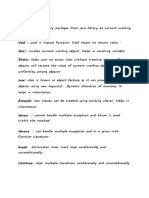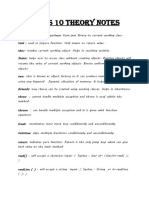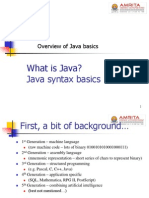0 ratings0% found this document useful (0 votes)
2 viewsJava notes
The document provides concise explanations of fundamental Java programming concepts, including the introduction to Java, JDK setup, data types, control structures, and object-oriented principles. It covers essential topics such as loops, methods, inheritance, encapsulation, and polymorphism, along with practical examples and usage. The content serves as a comprehensive guide for beginners to understand Java programming fundamentals.
Uploaded by
g.dejasviniCopyright
© © All Rights Reserved
Available Formats
Download as PDF, TXT or read online on Scribd
0 ratings0% found this document useful (0 votes)
2 viewsJava notes
The document provides concise explanations of fundamental Java programming concepts, including the introduction to Java, JDK setup, data types, control structures, and object-oriented principles. It covers essential topics such as loops, methods, inheritance, encapsulation, and polymorphism, along with practical examples and usage. The content serves as a comprehensive guide for beginners to understand Java programming fundamentals.
Uploaded by
g.dejasviniCopyright
© © All Rights Reserved
Available Formats
Download as PDF, TXT or read online on Scribd
You are on page 1/ 4
Here are short and precise two-mark explanations for each topic:
1. Introduction of Java – Java is a high-level, object-oriented, platform-
independent programming language used for developing applications.
2. JDK Setup – JDK (Java Development Kit) contains JRE and development
tools for writing, compiling, and running Java programs.
3. First Code in Java – Java programs start with a main() method inside a
class, using System.out.println() to print output.
4. How Java Works – Java code is compiled into bytecode, which is
executed by the JVM (Java Virtual Machine), ensuring platform
independence.
5. Variables – Variables store data in memory and have types like int,
double, char, and String.
6. Data Types – Java has primitive (int, float, char, etc.) and non-primitive
(String, Array) data types.
7. Literals – Fixed values assigned to variables, such as 10 (integer), 3.14
(float), and 'A' (char).
8. Type Conversion – Implicit (smaller to larger type) happens
automatically, explicit (larger to smaller) requires casting.
9. Arithmetic Operators – Used for calculations: +, -, *, /, %.
10.Relational Operators – Used for comparison: ==, !=, >, <, >=, <=.
11.Logical Operators – Used for conditions: && (AND), || (OR), ! (NOT).
12.If Else – Decision-making statement that executes different code blocks
based on conditions.
13.If Else If – Multiple conditions are checked using else if, allowing more
complex decision-making.
14.Ternary Operator – Shortened if-else using condition ? true_value :
false_value.
15.Switch Statement – Used for multiple case-based decisions instead of
multiple if-else.
16.Need for Loop – Loops are used to execute repetitive tasks efficiently.
17.While Loop – Executes a block of code while the condition remains true.
18.Do While Loop – Similar to while, but ensures execution at least once.
19.For Loop – A counter-based loop used for fixed iterations.
20.Which Loop to Use – Use for when the number of iterations is known,
while when it's unknown, and do-while for at least one execution.
21.Class and Object Theory – A class is a blueprint, and an object is an
instance of a class.
22.Class and Object Practical – Objects are created using new keyword and
access class properties.
23.JDK, JRE, JVM – JDK (Development), JRE (Runtime), and JVM (Execution)
together run Java programs.
24.Methods – Blocks of code that perform a specific task and can be called
multiple times.
25.Method Overloading – Defining multiple methods with the same name
but different parameters.
26.Stack and Heap – Stack stores method calls and local variables, while
Heap stores objects.
27.Need of Array – Arrays store multiple values of the same type efficiently.
28.Creation of Array – Arrays are declared using int[] arr = new int[5]; or
int[] arr = {1, 2, 3};.
29.Multi-Dimensional Array – Arrays with multiple indexes, like matrix[][].
30.Jagged and 3D Array – Jagged arrays have different row sizes, 3D arrays
have three dimensions (int[][][]).
31.Drawbacks of Array – Fixed size and cannot store different data types.
32.Array of Objects – Arrays can store objects of a class instead of
primitives.
33.Enhanced For Loop – Simplifies iteration over arrays using for (int num :
arr).
34.What is String – A sequence of characters, represented by the String
class.
35.Mutable vs Immutable String – String is immutable, while StringBuffer
and StringBuilder are mutable.
36.StringBuffer and StringBuilder – Both allow string modification, but
StringBuffer is thread-safe, and StringBuilder is faster.
37.Static Variable – Shared across all instances of a class.
38.Static Method – A method that belongs to the class, not an instance.
39.Static Block – Executes before main() when the class is loaded.
40.Encapsulation – Hiding data by making variables private and using
getters & setters.
41.Getters and Setters – Methods to access and modify private variables.
42.This Keyword – Refers to the current object inside a class.
43.Constructor – Special method to initialize objects when created.
44.Default vs Parameterized Constructor – Default has no arguments, while
parameterized takes arguments.
45.Naming Convention – Classes use PascalCase, variables/methods use
camelCase.
46.Anonymous Object – An object created without a reference.
47.What is Inheritance – A mechanism where one class acquires the
properties of another.
48.Need of Inheritance – Code reusability and avoiding redundancy.
49.Single and Multilevel Inheritance – Single (A → B), Multilevel (A → B →
C).
50.Multiple Inheritance – Not supported in Java but achieved using
interfaces.
51.This and Super Method – this calls the current class method, super calls
the parent class method.
52.Method Overriding – Child class redefines a method of the parent class.
53.Packages – Used to organize classes logically.
54.Access Modifiers – public, private, protected, and default control
visibility.
55.Polymorphism – Same method behaves differently based on context
(overloading, overriding).
56.Dynamic Method Dispatch – Calls overridden methods dynamically at
runtime.
57.Final Keyword – Used to prevent modification in variables, methods, and
classes.
58.Object Class equals, toString, hashCode – Methods inherited from
Object class to compare, print, and generate hash values.
59.Upcasting and Downcasting – Upcasting (Parent p = new Child();),
Downcasting (Child c = (Child) p;).
60.Wrapper Class – Converts primitive data types into objects (Integer,
Double, etc.).
You might also like
- Introduction To Ilogic: S.No Topic LinkNo ratings yetIntroduction To Ilogic: S.No Topic Link17 pages
- SAP EPC Enterprise Project Connection 2018No ratings yetSAP EPC Enterprise Project Connection 201819 pages
- imp terms & definitions 10th to email. (1)No ratings yetimp terms & definitions 10th to email. (1)13 pages
- CORE JAVA Syllabus: 1. Core Java Programming Introduction of JavaNo ratings yetCORE JAVA Syllabus: 1. Core Java Programming Introduction of Java9 pages
- Unit 1 - Intro To OOP and Java FundamentalsNo ratings yetUnit 1 - Intro To OOP and Java Fundamentals11 pages
- 22CS202 JAVA PROGG ANSKEY FIAT SIAT ME ESE 2022-2023No ratings yet22CS202 JAVA PROGG ANSKEY FIAT SIAT ME ESE 2022-202333 pages
- Java Programming_ Comprehensive Guide from Basics to AdvancedNo ratings yetJava Programming_ Comprehensive Guide from Basics to Advanced10 pages
- Java Tutorial: Write Once, Run AnywhereNo ratings yetJava Tutorial: Write Once, Run Anywhere50 pages
- IGNOU PGDCA MCS 206 Object Oriented Programming using Java Previous Years solved PapersFrom EverandIGNOU PGDCA MCS 206 Object Oriented Programming using Java Previous Years solved PapersNo ratings yet
- Select All Lines Using Personalization: On Manage Buyer Workload Form Utilities:Diagnostics YesNo ratings yetSelect All Lines Using Personalization: On Manage Buyer Workload Form Utilities:Diagnostics Yes10 pages
- Problem Solving and Python Programming LaboratoryNo ratings yetProblem Solving and Python Programming Laboratory59 pages
- CORE JAVA Syllabus: 1. Core Java Programming Introduction of JavaCORE JAVA Syllabus: 1. Core Java Programming Introduction of Java
- 22CS202 JAVA PROGG ANSKEY FIAT SIAT ME ESE 2022-202322CS202 JAVA PROGG ANSKEY FIAT SIAT ME ESE 2022-2023
- Java Programming_ Comprehensive Guide from Basics to AdvancedJava Programming_ Comprehensive Guide from Basics to Advanced
- IGNOU PGDCA MCS 206 Object Oriented Programming using Java Previous Years solved PapersFrom EverandIGNOU PGDCA MCS 206 Object Oriented Programming using Java Previous Years solved Papers
- Select All Lines Using Personalization: On Manage Buyer Workload Form Utilities:Diagnostics YesSelect All Lines Using Personalization: On Manage Buyer Workload Form Utilities:Diagnostics Yes

























































































